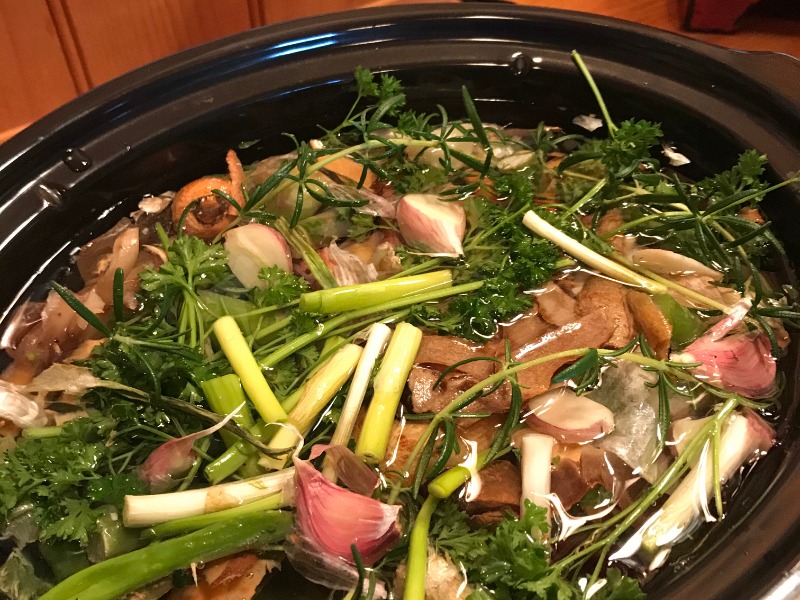Homemade Bone Broth

Bone Broth: Memories of Our Childhood
Our sense of smell is strongly linked to our memories. Nothing brings back better memories for us than the smell of bone broth simmering on the stove or in the slow-cooker. Your memory might be more about having homemade chicken soup when feeling a little under the weather. Whatever memories it conjures, bone broth should be a staple in everyone’s kitchen. It is easy to make and is a great way to use up leftover vegetable scraps and chicken bones.
Bone Broth: A Healing Elixir
Bone broth provides many health benefits. It should be noted that these will vary according to the bones and vegetables used to make your bone broth. In general, bone broth is rich in minerals such as calcium, magnesium, phosphorus, silicon, sulphur and other trace minerals. It is especially rich in proteins, providing various essential amino acids to the body such a gelatin, glycine, proline and glutamine. Gelatin, glycine and proline are linked to the prodcution of collagen, an essential protein for all connective tissues in the body (cartilage, tendons, bones, hair, nails, skin, etc.). Glutamine is another important protein that is very healing for the gut. Bone broth is also great at reducing overall inflammation in the body . The more jelly-like your broth is, the more it will be beneficial. Although there is some controversy regarding the benefit claims of bone broth, no one can dispute that it does bring comfort every time we sip it. Anectodal evidence is good enough for us!
Bone Broth in Everyday Cooking
Once you have bone broth, you can use it as the base for your soups and stews. It will increase the nutrient profile of your meals and add lots of flavour. We love to cook our favourite grains in bone broth as well. So next time you cook rice, quinoa, or lentils, add a little broth to the water.
The Learning Kitchen with Lyne
Watch Lyne in action as she shows you how to make bone broth, step-by-step in this Learning Kitchen video.
Click gut-healing-bone-broth for the printable version of this recipe.
Makes approx. 8 cups
Prep time: 10 minutes
Cook time: 10-12 hours on LOW
What you need:
- 1 Ziploc bag full of vegetable peels, stems, cores, etc.*
- 5-7 cloves garlic
- 3-4 lbs. organic meat bones or leftover bones from one roasting chicken
- 2-3 dried bay leaves
- any fresh herbs you have on hand (optional)
- 1 tablespoon sea salt
- 1/3 cup raw apple cider vinegar
What you do:
- Place all ingredients in a slow-cooker. Add enough pure filtered or spring water to cover the bones and vegetables.
- Cook on low heat for at least 10 to 12 hours (you can cook longer and get even more nutrients).
- Pour the broth through a fine-mesh strainer and discard all the bones and vegetables.
- Taste the broth and adjust seasoning to taste.
- Store in the fridge for up to 3 days or in the freezer for up to three months.
Nutrient Information per 1 cup (using the Fresh Vegetable Alternative):
Fat 0g Carbs 6g Fibre 1g Sugar 4g Protein 7g
(Note that these numbers will vary according to the bones and vegetables used.)
Culinary Tips:
- *Keeping vegetable “scraps”: As you use vegetables in various recipes, keep the cleaned peels and discarded pieces and store them in a Ziploc bag in the freezer. Keep adding to the bag until it is full. Then it’s time to make bone broth.
- Vegetarian version: omit the bones and use vegetables only.
- Fresh vegetable alternative: if you don’t have any vegetable scraps, then use 2 unpeeled carrots, 2 stalks of celery with leaves, two medium onion with skin, and any other vegetable you have on hand. Chop in big pieces and add to the crockpot.
Bon appétit!

When it comes to food, the whole C’est La Vie Wellness team is on board. Some of us love to create while others enjoy testing some of our latest creations. Enjoy trying these recipes and please share pictures on your social media…and make sure to tag us! Bon appétit!
